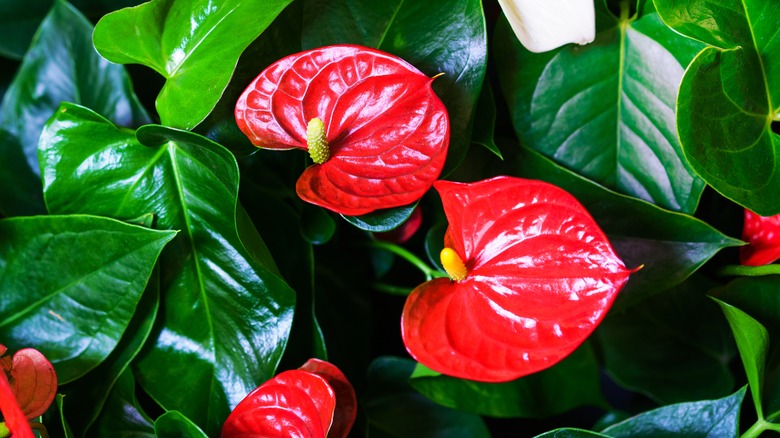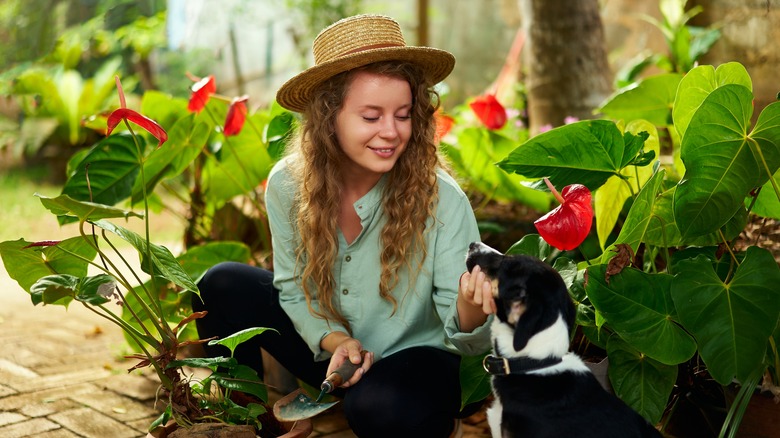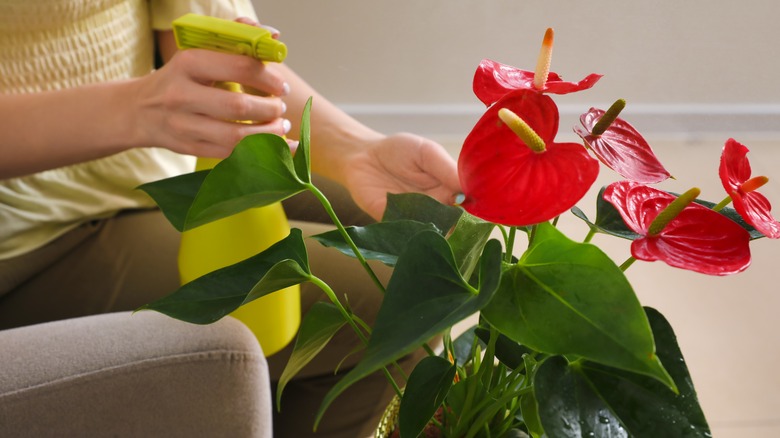The Flamingo Flower Is A Stunning Plant Pet Owners Should Be Wary Of
This showstopper plant has an appearance as exotic as its name. The flamingo flower, more formally known as Anthurium andraeanum, is native to Central and South America, but is commonly grown as an indoor houseplant in all climates. With glossy leaves and vibrant, festive colors, the flamingo flower is a gorgeous addition to any home. It's also a satisfying alternative or addition to traditional house plants that spice up your holiday decor such as poinsettia or amaryllis; however, this plant's irresistible beauty could come at a concerning cost if you have pets. According to the ASPCA, dogs and cats can suffer adverse health effects if they nibble on any part of this houseplant.
Flamingo flower is very recognizable for its brightly colored heart-shaped blooms. Each waxy "flower" is actually made up of a modified leaf called a spathe and a yellow or red spike called a spadix. The spadix resembles a corn cob, but is actually rows of tightly packed tiny flowers. These brightly colored blooms can last for two to three months at a time, and the plant blooms year-round when well cared for. This consistent display of color makes flamingo flower a popular choice for interior spaces.
A potential household hazard
Flamingo flower's beauty comes with a warning for pet owners. Anthurium plants in general are among several varieties of house plants that might need to be avoided in a home with pets. Plants in the Anthurium family contain an organic compound called calcium oxalate, which could injure cats and dogs. Calcium oxalate is a microscopic array of spiky crystals that can cause significant irritation if touched or ingested. If eaten, it can cause pain and swelling of the mouth and tongue, as well as upper airway irritation. Pets that have ingested the plant may also show signs of distress by drooling, vomiting, and having difficulty swallowing. If you see your pet exhibiting any of these symptoms or if you observe them eating this plant, the ASPCA recommends calling your vet or their 24-hour animal poison control hotline immediately.
The good news is that an initial spiky sensation discourages most pets from eating very much of the plant. The leathery texture of the leaves is also a deterrent. However, it's still wise to avoid growing flamingo flower if you have curious pets in your home. Alternatively, you may choose to grow them in an area that is inaccessible to them or in hanging baskets out of reach.
It's worth noting that flamingo flower is also mildly poisonous to humans and can cause skin irritation when touched. It's recommended to wear gloves when working with the plant and to avoid touching your eyes and nose.
Steps to success with flamingo flower
Despite these safety concerns, many people still choose to own and properly care for flamingo flower and the steps to success are fairly straightforward. Unless you live in the tropics, this plant will need to be grown indoors as a houseplant.
You'll need a well-draining pot with acidic soil. An equal ratio of potting soil and orchid mix is ideal. You should water your plant one to two times per week, keeping the soil moist but not waterlogged to avoid root rot. The plant will require about six hours of indirect sunlight per day, ideally in warm and moderately humid conditions. If you live in an arid climate, you can mist the plant daily or set it near a humidifier. Fertilizing regularly is also required. It's recommended to use a water-soluble fertilizer according the product instructions during the growing season.
Alternatively, the flamingo flower can also be grown hydroponically in water indoors. This mess-free method avoids the use of soil altogether, but does require more plant food and regular fertilizing for best results.


